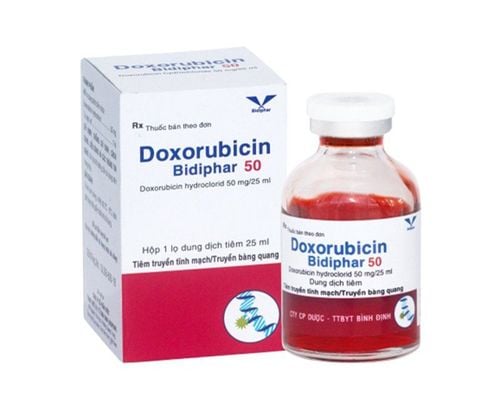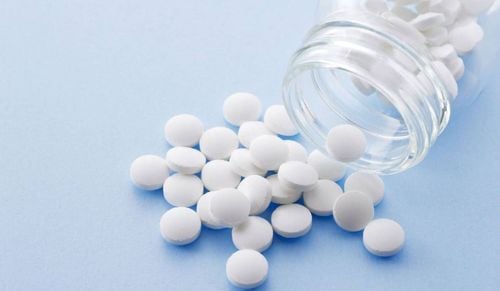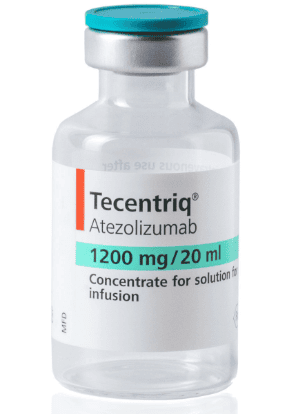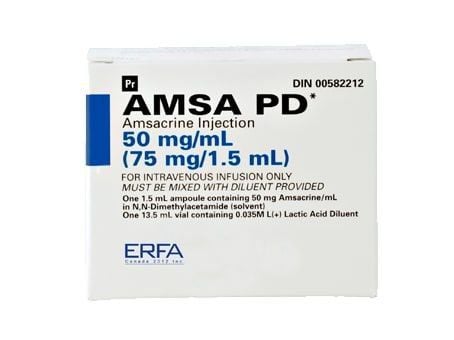This is an automatically translated article.
On the market today, there is a lot of information about Asparaginase drug products, but it is still incomplete. To better understand the drug L-asparaginase, what are the uses and side effects, let's learn more in the article below.
1. What is L-asparaginase?
L-asparaginase is a drug indicated for the treatment of cancer, belonging to the group of prescription ETC (Ethical drugs, prescription drugs, Prescription only medicine). L-asparaginase may be combined (or not needed) with other anticancer (chemotherapy) medicines. L-asparaginase with main ingredient L-Asparaginase helps to treat patients with acute lymphoblastic leukemia (ALL) who have developed hypersensitivity to asparaginase derived from E. coli, a drug manufactured by Naprod Life Sciences PVT.Ltd – India.
The composition of l asparaginase includes: L-Asparaginase 10000IU.
Dosage form: Powder for solution for injection / infusion.
1.1. Drug form and drug content L-Asparaginase Vial of 10,000 international units (United Nations) in the form of powder or in the form of a button-shaped lyophilized block, sterilized white, very soluble in water. Each vial contains 80 mg of mannitol as an inactive ingredient.
1 The QTc of L-asparaginase would be equivalent to the amount of enzyme that causes 1 micromol of ammonia in 1 min from L-asparagin under standard conditions (37 oC).
1.2. Pharmacology of the drug L-asparaginase
L - asparaginase is the left-rotating isomer of a large molecular weight protein, extracted from Escherichia coli and other bacteria. This enzyme hydrolyzes asparagin, an essential amino acid found in serum, thereby depriving the body of an element required for protein synthesis in susceptible malignant lymphocytes. In acute leukemia and especially acute lymphoblastic leukemia, malignant cells must depend on an external source of asparagin for survival; While normal cells can synthesize asparagin, they are less affected by asparagin deficiency due to asparaginase treatment. Recently, however, it has also been found that many normal tissues are sensitive to asparaginase and can cause toxicity of varying degrees. In addition, human diseased white blood cells can rapidly develop drug resistance due to the emergence of strains containing asparaginase synthetase. This is also the reason people often use drugs in combination with other chemicals.
1.3. The pharmacokinetics of L-Asparaginase Intravenous and intramuscular injection will both have similar serum concentrations, but after intramuscular injection, peak plasma concentrations are reached 14 to 24 hours after administration. The drug is not significantly distributed outside the vascular compartment and is excreted in the bile and urine very little. Asparaginase remains detectable in serum 13 to 22 days after administration. The half-life of asparaginase will vary from 8 to 30 hours and is independent of dose. The apparent volume of distribution is about 70% to 80% of plasma volume. In lymphatic and cerebrospinal fluid, asparaginase was detected.
2. What are the uses of L-asparaginase?
Acute leukemia (including chronic leukemia), especially acute lymphoblastic leukemia. Malignant lymphoma, lymphosarcoma. It is mainly used in combination with other chemotherapeutic agents to induce episodes of remission in children. L-asparaginase should not be used alone unless combination therapy is inappropriate and maintenance therapy with this drug is not recommended.
Comply with the correct use of the drug according to the indications (uses, functions for whom) stated on the L-asparaginase instruction sheet or the doctor's prescription sheet.
3. Side effects of the drug L-asparaginase
The following side effects are common (occurring in more than 30%) for patients taking asparaginase:
Fever and chills (flu-like symptoms); Nausea and vomiting; Allergic reactions, such as sudden wheezing, itching, rash, swelling of the face, agitation, low blood pressure. You will be closely monitored for this reaction; Eat poorly; Abdominal cramps; CNS toxicity : Excessive somnolence, depression, hallucinations, agitation and disorientation or convulsions. Rarely, dizziness, confusion, and/or coma are common. These side effects were less common (occurring in about 10-29%) of patients taking Asparaginase :
Mouth ulcers; Pancreatitis (acute pancreatitis) may occur in up to 10% of patients. Mainly it should be noted in the blood tests returning to normal after stopping treatment. Rarely can cause serious symptoms. Symptoms of acute pancreatitis include pain in the upper abdomen that worsens with eating, abdominal swelling and tenderness, nausea, vomiting, fever, and rapid pulse; Blood test abnormalities, such as increased blood sugar levels; Increase blood tests that measure liver function. They should return to normal after treatment is stopped (see liver problems); Coagulation disorders and increased risk of bleeding and clotting. Not all side effects are listed above. Some rare cases (occurring in less than 10% of patients) are not listed here. However, you should also always notify your healthcare provider if you experience any unusual symptoms.
Contact your doctor right away if you experience any of the following symptoms:
Fever 100.4°F (38°C) or higher, chills (possibly a sign of infection); Nausea (impaired ability to eat and drink without prescription); Vomiting (vomiting more than 4 to 5 times in 24 hours); stomach pain that persists or gets worse when you eat; Abdominal swelling; Diarrhea (4 to 6 episodes in a 24-hour period); Unusual bleeding or bruising; Swelling, redness, and/or pain in one leg or arm, not the other; Extreme fatigue (inability to perform self-care activities); Yellowing of the skin or eyes; Unusual thirst and need to urinate often; Confusion, excessive sleepiness, and hallucinations (seeing, hearing, or feeling things that aren't there); agitation or disorientation (inability to recognize familiar surroundings). 4. Drug interactions Using L - asparaginase intravenously at the same time or before the treatment of Vincristin and Prednisolone may increase toxicity.
Asparaginase may reduce or neutralize the effect of methotrexate on malignant cells. The inactivation of Methotrexate will persist as long as Asparagin is hydrolysed by Asparaginase, since Methotrexate's effect requires Asparagin for cell replication.
Asparaginase also reduces clearance of Vincristin.
Asparaginase affects thyroid function test results because it rapidly and clearly reduces serum Thyroxin-bound Globulin concentrations within 2 days after the first dose. This level will return to pre-treatment values 4 weeks after the last dose of Asparaginase.
5. Dosage and effective use of L-asparaginase 5.1. How to use L-asparaginase Use intravenously or intramuscularly or subcutaneously
5.2. Dosage of L-asparaginase Drug dosage may be calculated according to body surface area or weight. L-asparaginase is commonly used in conjunction with other cytotoxic agents in multivalent formulations for acute lymphoblastic leukemia of both adults and children and non-Hodgkin's lymphoma...
Oral dosing intravenous in some formulas such as:
6 000 QT/m2/dose x 3 times/week; Or 1,000 units/kg/day x 10 days; Or high dose is: 10 000 units/m2/day x from 3 to 12 doses. Dose for monotherapy (rarely) 200 IU/kg/day x 28 days. Dosage by intramuscular route is available in a number of formulas such as:
6 000 IU/m2/dose x 3 times/week for 6 - 9 doses; or 6 000 QT/m2/dose, 1 dose every 3 days for 6 to 9 doses; High dose is: 10 000 units/m2/day x from 3 to 12 doses. Test dose: It is recommended to do before the first dose or before the date of reintroduction of the drug after a break. Use 0.1 ml of 20 IU/ml (2 units) diluted intradermally and monitor the patient for at least 1 hour.
Some other ways commonly used in combination in a multi-chemotherapy regimen:
Intramuscular: 6 000 to 10 000 IU/m2/dose x 3 times/week x 3 weeks. High dose intramuscularly with 25,000 units/m2/dose/week once x 9 doses. Intravenous with: 6 000 units/m2/dose x 3 times/week x 6 to 9 doses or 1,000 units/kg/day x 10 days or 200 units/kg/day x 28 days. Note: L-asparaginase is also used in other combination regimens. But it should be remembered that intravenous administration at the same time or just before the use of Vincristin and Prednisolone increases toxicity. Physicians using a regimen should be fully aware of the benefits and risks of that regimen. Clinical data are still insufficient to recommend the use of combination regimens for adults, but it is clear that the toxicity of Asparaginase in adults is higher than in pediatric patients.
L-asparaginase should only be used alone in special situations, when combination regimens are not appropriate due to toxicity, patient-related factors, or in cases where the disease is refractory to the drug. other.
When Asparaginase is used alone in adults and children, the recommended dose is 200 IU/kg/day intravenously for 28 days. But it is also possible to use Asparaginase alone under other regimens. Physicians who will use any regimen must be familiar with the benefits and risks of that regimen.
Patients who have received 1 course of L-asparaginase, if re-treated, the risk of hypersensitivity reactions is often increased. Therefore, it should be reintroduced only when the benefits outweigh the risks.
Method of desensitization: Desensitization is a non-sensitizing treatment that is carried out for those who react to Asparaginase at the first dose and who are on the treatment again. This procedure is to gradually increase the dose of Asparaginase provided adequate preparations are made to manage acute allergic reactions should they occur.
May be given as follows: Start with a dose of 1 IV QT, then give a double dose every 10 minutes (if no reaction occurs) until a total dose equal to the required dose is reached. for that day.
5.3. Overdose and treatment when using L-asparaginase
Symptoms of shock may occur (even with usual doses). If there are symptoms such as cloudy consciousness, convulsions, hypotension, chills, fever or vomiting, the drug should be discontinued immediately and appropriate management measures taken.
There is no antidote. If there is an anaphylactic reaction, it is necessary to immediately use Epinephrine, Oxygen and intravenous corticosteroids. Insulin may be required to treat hyperglycemia.
6. Be careful when taking L-asparaginase
With prolonged use, extreme caution should be exercised because of the potential for serious and prolonged adverse reactions. Particular attention should be paid when infection or bleeding occurs, or if more severe symptoms are observed.
Using drugs for children and pregnant women should be careful because the drug has a strong effect on the gonads. It should be used with caution in patients with liver and kidney dysfunction, marrow failure, infections and chickenpox (which can cause systemic disorders leading to death).
Asparaginase has an immunosuppressive effect that can lead to bacterial infections. Toxicity due to Asparaginase is usually more severe in adults than in children.
7. Preservation of L-asparaginase Drugs Preservation. Unused reconstituted solution should be stored at 2-8°C and discarded after 8 hours or sooner if the solution is cloudy. The shelf life is about 1 year. The diluted solution, if it comes into contact with the rubber stopper, may be denatured, forming insoluble fibers.
Carefully read the instructions for storage of the drug on the package and the leaflet for use of L-asparaginase. Check the expiry date of the medicine. When not in use, the drug should be collected and disposed of according to the manufacturer's instructions or the person in charge of medicine. Conventional drugs are stored at room temperature, avoiding direct sunlight or high temperature, which can cause metabolism of the ingredients in the drug.
Please dial HOTLINE for more information or register for an appointment HERE. Download MyVinmec app to make appointments faster and to manage your bookings easily.













